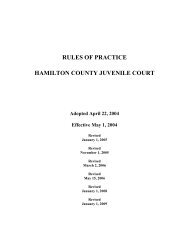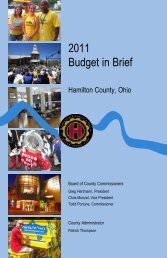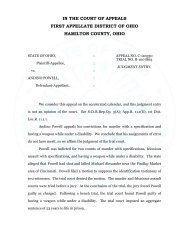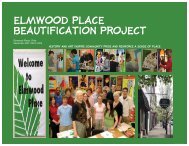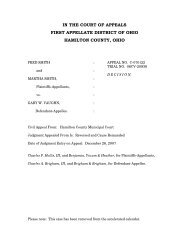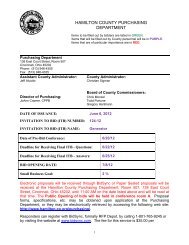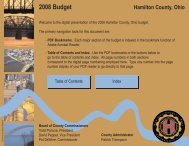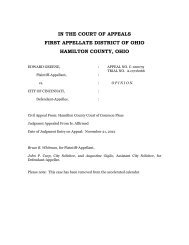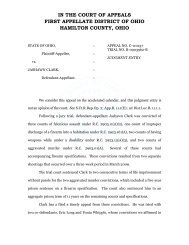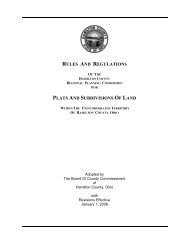Planning in The Age of Sprawl - Hamilton County, Ohio
Planning in The Age of Sprawl - Hamilton County, Ohio
Planning in The Age of Sprawl - Hamilton County, Ohio
You also want an ePaper? Increase the reach of your titles
YUMPU automatically turns print PDFs into web optimized ePapers that Google loves.
admits to be<strong>in</strong>g pro-sprawl—it’s not a nice word! I once was told that sprawl is what a slob<br />
with a big belly and a beer can is do<strong>in</strong>g when he is draped across the s<strong>of</strong>a watch<strong>in</strong>g<br />
wrestl<strong>in</strong>g--<strong>in</strong>ferr<strong>in</strong>g that anyth<strong>in</strong>g characterized as sprawl<strong>in</strong>g cannot be good. However,<br />
residents <strong>of</strong> suburban neighborhoods--many oblivious to the fact that “<strong>Sprawl</strong>-R-Us”--are<br />
great champions <strong>of</strong> suburban liv<strong>in</strong>g. Indeed, the suburban neighborhood—with or without<br />
the label <strong>of</strong> sprawl--is exactly what most suburban residents want. That’s why they live<br />
there! And, that’s been made quite clear to me at many public meet<strong>in</strong>gs dur<strong>in</strong>g discussions<br />
about community values and goals. Many surveys support the claim that low density<br />
settlement is the overwhelm<strong>in</strong>g choice for residential liv<strong>in</strong>g.<br />
Current land use and development practices are defended by many. Supporters <strong>of</strong><br />
conventional suburban development (i.e., the predom<strong>in</strong>ant suburban character built s<strong>in</strong>ce<br />
1950) deem the use <strong>of</strong> the term sprawl to be pejorative. <strong>The</strong>y prefer terms describ<strong>in</strong>g<br />
development such as suburban, dispersed, decentralized, discont<strong>in</strong>uous and multi-centered,<br />
multi-nodal or polycentric. Proponents <strong>of</strong> the status-quo note that conventional patterns <strong>of</strong><br />
development are necessary to economic prosperity, that open space is meant to be enjoyed at<br />
home--not after a long drive outside the growth boundary. <strong>The</strong>y are proponents <strong>of</strong> an<br />
abundance <strong>of</strong> privatized open space <strong>in</strong> the form <strong>of</strong> front and back yards. In their view, the<br />
net effects <strong>of</strong> conventional development patterns are overwhelm<strong>in</strong>gly positive, contribut<strong>in</strong>g<br />
to economic growth and to the social objective <strong>of</strong> widespread homeownership—exactly as<br />
envisioned by the 1939 World’s Fair where the most popular exhibition was General<br />
Motor’s “World <strong>of</strong> Tomorrow”, featur<strong>in</strong>g an enormous model <strong>of</strong> an auto-utopia called “City<br />
<strong>of</strong> the Future”. Another social benefit <strong>of</strong>ten cited as a positive result <strong>of</strong> the current suburban<br />
development strategy is “filter<strong>in</strong>g down” or mak<strong>in</strong>g <strong>in</strong>ner city hous<strong>in</strong>g available to lower<strong>in</strong>come<br />
people as it is vacated by others mov<strong>in</strong>g up and out. Indeed, n<strong>in</strong>eteenth- and early<br />
twentieth-century reformers, who viewed the congestion <strong>of</strong> the city as a pr<strong>of</strong>ound evil would<br />
have looked at today’s decentralization or “suburban sprawl” (GM’s “World <strong>of</strong> Tomorrow”<br />
that we live <strong>in</strong> today) as an improvement too good to be imag<strong>in</strong>ed. 1<br />
<strong>The</strong> Wells Fargo Bank, <strong>in</strong> Preserv<strong>in</strong>g the American Dream, defends the current development<br />
patterns say<strong>in</strong>g that current suburbia is simply <strong>in</strong> the early stages <strong>of</strong> development. Over time<br />
these suburbs will transform <strong>in</strong>to higher density areas support<strong>in</strong>g developed commercial<br />
economies as well as jobs—a process <strong>of</strong> dispersal followed by later <strong>in</strong>fill. <strong>The</strong> theory<br />
resembles the natural growth and evolution <strong>of</strong> forests (succession <strong>of</strong> weed, grass, and forest<br />
communities) where early stages are essential but not as attractive or useful as a mature<br />
forest. In their view, the utopic visions <strong>of</strong> the 1940’s and 1950’s have been achieved—Why<br />
fix what isn’t broke <strong>The</strong>y assert that the traffic consequences <strong>of</strong> suburban development are<br />
benign s<strong>in</strong>ce commutes shorten as jobs move to the suburbs to be closer to the labor force.<br />
In their view, consumer preference for low-density, s<strong>in</strong>gle family homes is so entrenched<br />
that any alternative to the current suburban spatial order will never have anyth<strong>in</strong>g wider than<br />
a boutique appeal. 1<br />
<strong>The</strong> Wells Fargo view is reiterated <strong>in</strong> Jack Nasar’s <strong>The</strong> Evaluative Image <strong>of</strong> the City. He<br />
expla<strong>in</strong>s that design pr<strong>of</strong>essionals don’t share the values <strong>of</strong> the public and don’t deliver those<br />
values <strong>in</strong> designs and plan: “For more than 60 years, planners and designers have attacked<br />
the suburban landscape. Yet the public around the world cont<strong>in</strong>ues to evaluate it favorably<br />
as the ideal.”<br />
HCRPC<br />
PLANNING IN THE AGE OF SPRAWL<br />
3



